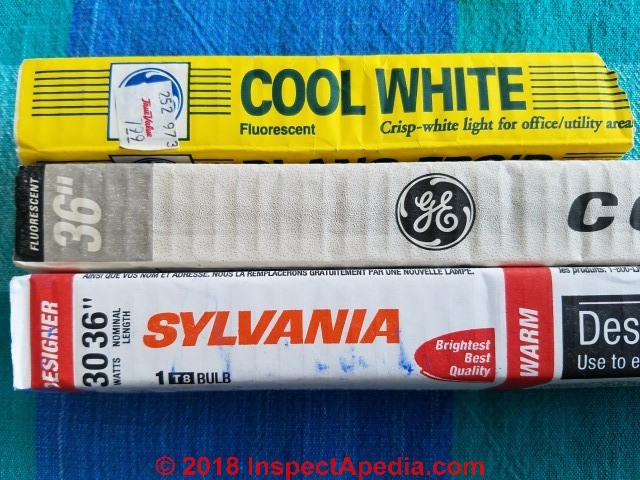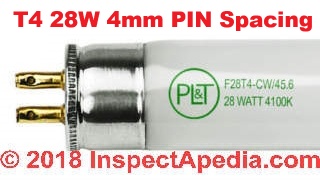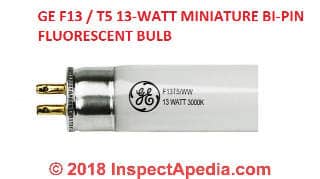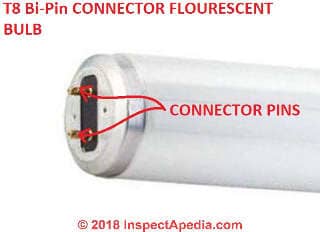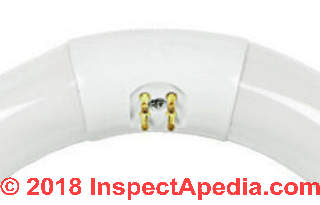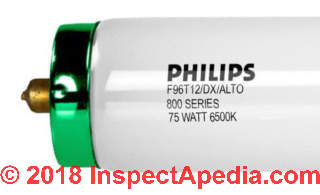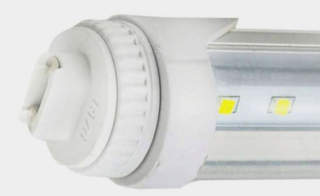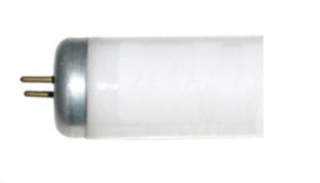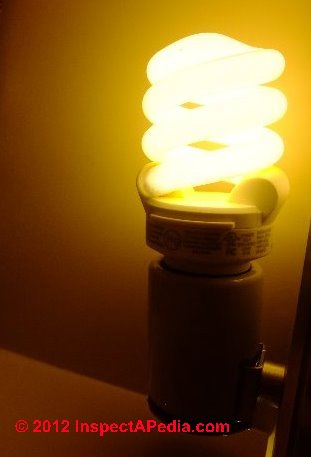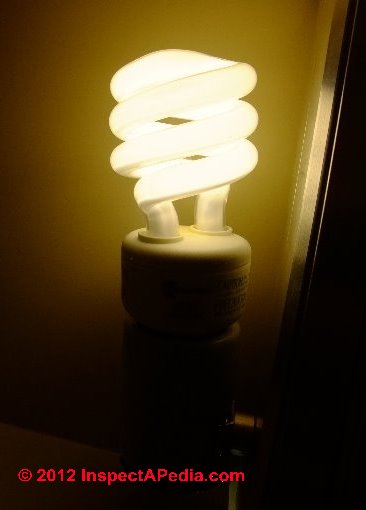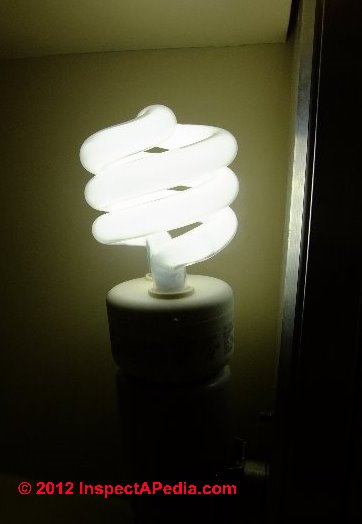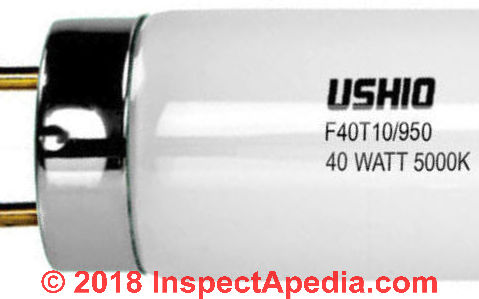 Fluorescent Lamp Codes
Fluorescent Lamp Codes
Types, codes, connector bases for fluorescent bulbs
- POST a QUESTION or COMMENT about building electrical systems, power, wiring, and flickering or dimming lights
Here we describe the different types of fluorescent lamps or "bulbs" by size, shape, connector, wattage, color temperature and other features.
This article series explains how to diagnose the causes of flickering, dim, or dead fluorescent lights at or in buildings.
Watch out: flickering or dimming lights might indicate a dangerous condition risking a building fire or an electrical shock. If the simple bulb or starter repairs we describe here don't cure the flickering, switch off the bad-acting light fixture, leave it off, circuit and ask for help from a licensed electrician.
InspectAPedia tolerates no conflicts of interest. We have no relationship with advertisers, products, or services discussed at this website.
- Daniel Friedman, Publisher/Editor/Author - See WHO ARE WE?
Identify Fluorescent Lamp Types / Bulb Codes
Photo: Packaging for T8 fluorescent bulbs. The property owners whose lights I was repairing had kept the original packaging for two generations of GE brand T8, 36-inch fluorescent bulbs that were used in various fixtures in the home.
The Sylvania T8 bulb shown by the bottom-packaging is a perfect replacement.
Keeping the original bulb package (or writing down what type of bulb was installed) means that even if you have the bad luck to break a bulb and your client throws away your carefully-kept bulb base, you can still identify the proper replacement lamp.
Article Contents
- FLUORESCENT BULB / LAMP SPECIFICATIONS
- TABLE of ALL FLUORESCENT BULB TYPES - bulb code, bulb diameter, bulb socket type
- PHOTO GUIDE to FLUORESCENT BULB SOCKET / CONNECTOR TYPES
- FLUORESCENT BULB COLOR TEMPERATURE CHOICES
- RESEARCH - Fluorescent vs LED vs other bulb types, bases, etc: cost, lighting, life
...
Fluorescent / tubular lamp or bulb specifications
Some of bulb specifications below are redundant: for example if you know that it's a T5 bulb you know that it is a 5/8" (15.8mm) diameter lamp with a G5 bi-pin connector.
- Bulb type:
Traditional fluorescent bulbs can often be replaced by an LED version bulb that is of the same dimensions and uses the same connectors.
Currently (March 2025) LED tubular bulbs that are a plug-in replacement for a traditional fluorescent bulb cost at least twice as much per bulb.
Watch out: as we explain in detail at LED BULB REPLACES FLUORESCENT , while LED bulbs can be substituted for traditional fluorescent lamps, you may need to change the fixture wiring, such as by bypassing or removing the traditional bulb ballast assembly.
- Bulb length: e.g. 36" long bulbs (shown above)
- Bulb shape: e.g. straight tube, round or curved tube, spiral tube.
- Bulb diameter: 1/8" (3.175mm) - 5/8" (15.875mm) - 1" (25mm) - 1.5" (38mm)
- Bulb pin specifications: spacing and size
- Bulb wattage: 4 W up to 125 W. Most residential bulbs are in the 4W to 60W range; note that bulb length and wattage generally change together
However there are some fluorescent bulb substitutions that will work such as traditional fluorescent vs. LED or bulb color or diameter.
You can not install a shorter bulb into the existing fluorescent light fixture than the original, but you may find a bulb that is
- a different color temperature
- a different overall diameter - but with connector pins that match the original in spacing
In U.S., Canadian, European and some other communities you'll pay a small recycling fee - an environmental handling charge - that covers the safe-handling and disposal of these older bulbs, some of which contain mercury.
...
Complete Guide to Types of Fluorescent Bulb Sizes & Types
Types of Fluorescent Bulbs: code, diameter, socket type |
|||
| Bulb Type Code |
Tube Diameter | Socket Type | Comments |
| T2 | 1/4" - 7mm | WP4.5×8.5d | |
| T4 | 1/2" 0 12.7 mm | G5 Bi-Pin | |
| T5 / T16 | G5 Bi-Pin |
Smaller, light-weight bulbs, architectural & high bay applications, produce more light per fixture than T8s. Uses miniature Bi-Pin base, or G5 base, pin spacing 5 mm |
|
| T8 / T26 | 1" - 25.4 mm
|
G13 bi pin / single pin / recessed double contact |
Higher efficiency replacement for traditional 40W T12 lamps, 32 Watts, vary in color temperature. T8s replace T12s, give about the same light output at 60% of the T12 bulb size. Uses Medium Bi-Pin base, or G13 base, pin spacing 13 mm Change older magnetic to newer electronic ballast if converting from T12 to T8 |
| T8 LED Replacements | 1" - 25.4 mm | G13 bi pin / single pin / recessed double contact | LED linear T8 Tubes can replace conventional T8 lamps IF an electronic T8 ballast is used. If when installing an LED replacement for a fluorescent bulb the light fixture contains a T12 ballast that device must be bypassed or simply removed completely. Also see LED BULB & LIGHTING TYPES |
| T9 / T29 | 1 1/8" - 28.6 mm | G10 quad pin | Circular fluorescent 4-pin connector |
| T10 | 1 1/4" - 31.75 mm
|
G13 bi pin | High-wattage, (40W) high-lumen alternative to T12 Uses Standard F40T12 magnetic or electronic ballast Uses Medium Bi-Pin base, or G13 base, pin spacing 13 mm Some versions provide a 4-pin connector at one end of bulb, specialty, e.g. germicidal fluorescent |
| T12 / T38 | 1 1/2" - 38.1 mm
|
G13 bi pin / single pin / recessed double contact |
Older, traditional design, US EPACT mandates phase-out in many applications, replaced by T5, T8, CFL Change older magnetic to newer electronic ballast if converting from T12 to T8 T12 bulbs used electromagnetic induction to create light; replacements use newer electronic ballasts. Uses Medium Bi-Pin base, pin spacing 13 mm. Alternative T12 bulbs using a single center pin single connect to an Fa6 base. The single pin is 6mm in diameter. |
| T17 / PG17 | 2 1/8" - 54 mm | Mogul bi pin or recessed double contact | GE Power-Groove™ and other brands Connect to a Mogul Bi-Pin G20 base. Some models connect to an R17d base, recessed connectors, pin spacing 17mm |
| CFL Compact fluorescents | 1/2" - 5/8" | Edison base screw-type bulb / lamp | Tube doubles back, curls, bends to produce a bulb that replaces traditional incandescent lamps |
Notes to the table above
 Our sketch illustrates that on both older T12 fluorescents and T8 fluorescent lamps the bulb's connecting pin dimensions and spacing are identical even though the T8 is a significantly-smaller-diameter bulb.
Our sketch illustrates that on both older T12 fluorescents and T8 fluorescent lamps the bulb's connecting pin dimensions and spacing are identical even though the T8 is a significantly-smaller-diameter bulb.
- Fluorescent lamps (or "bulbs" in normal-speak) are classed by shape, diameter, length, wattage, and often special properties and color temperature.
- In T numbers like Tn or T5, T8, etc. "T" indicates tubular lamp shape
- The fluorescent bulb's T-number in essence gives the bulb diameter and its connecting pin design.
T4 = 4/8" bulb diameter or 1/2"
T5 = 5/8" bulb diameter
T8 = 8/8" bulb diameter or 1"
T12 = 12/8" bulb diameter or 1 1/2"
Within a given bulb size in diameter or type, the light output or bulb wattage will vary by bulb length. - Most-common fluorescent bulbs discussed here are straight, of varying lengths, base, wattage and color temperature. U-shaped, circular, spiral and other shaped fluorescents, high output lamps, and lamps with reflectors as well as other designs are available.
- Bi-pin bulbs use a conventional ballast and starter unless the light fixture has been converted to use an LED replacement for a conventional fluorescent bulb - a step that can be taken if the ballast is a newer electronic type. Remember you will have to change older magnetic ballast to the newer electronic ballast if converting from T12 to T8 fluorescent bulbs.
- Single-pin bulbs may use an instant-start ballast and will not have a separate starter
- Fluorescent-lamp formats, retrieved 2018/09/02, includes notes from this original source: https://en.wikipedia.org/wiki/Fluorescent-lamp_formats
- Dimming ballasts are available for fluorescent light fixtures.
- Also see BULB & LAMP TYPES GUIDE - home
...
Photo Guide to Fluorescent Bulbs by Connector / Base
These photos show the different types of connectors, pins, or bulb bases for various fluorescent lamps. The illustrations are not to scale.
For fluorescent light fixture bulb dimensions see the table above on this page.
Above: T2 Fluorescent bulb, 8 watt, from Bulbrite®
Above: T4 Fluorescent bulb, 28 watt, from PL&T®, pin spacing 4 mm.
Above: T5 Fluorescent bulb, 13 watt, from GE®, pin spacing, 5 mm. Connects to miniature G5 base.
Above: T8 Fluorescent bulb, 32 watt, pin spacing 13mm, sold in a wide range of color temperature and light output in lumens, straight or U-shaped.
Connects to a medium Bi-Pin G13 base.
Above, the 4-pin connector segment of a T9 circular fluorescent, 32-watt.
Above: T10 fluorescent lamp, high output 40-Watt, connects to a medium Bi-Pin G13 base.
Above: T12, center pin, F96T12/DX/ALTO fluorescent bulb from Philips, 75 Watt, connects to a single pin Fa6 base.
Above: a T12 LED replacement bulb for T12 fluorescents using a type R17D base connector.
Above: a T17 fluorescent lamp produced by GE. This 180-Watt T17 lamp connects to a Mogul Bi-Pin (G20) base.*
*Definition of Mogul Base Bulbs
Mogul base bulbs are designed to tolerate higher operating temperatures and thus to permit greater light output in lumens. These bulbs are often preferred for commercial or industrial lighting.
Mogul base bulbs, often using porcelain to resist heat damage, and are most common in mogul (screw) type based lamps or bulbs. A screw type mogul base bulb is designated by the code E39 (39mm screw base diameter) and is larger than a conventional standard medium screw base bulb designated by the bulb base code E26 (26mm screw base diameter).
Mogul base bulbs are typically in the 250-1000 watt range and are sold also as LEDs and as mogul base compact fluorescent bulbs, also as mogul base mercury vapor, metal halide and even high pressure sodium. 2-56.
...
Fluorescent Lamp Color Temperatures
The color temperature of fluorescent lamps is adjusted by the manufacturer by changing the chemistry of the phosphorescent coating lining the inside of the lamp tube.
Above and below in order we show four CFL Edison base (screw-in type) fluorescent bulbs of different color temperatures. We kept the camera on the same "automatic" white balance setting for all four bulb color photographs.
- Soft white compact fluorescent bulb
- Bright white compact fluorescent bulb
- Daylight compact fluorescent bulb
The accuracy of color rendition of different lights and the CRI scale are explained at Color Temperature and CRI for Indoor Lights.
These colors are not exactly what your eye will see, nor do they consider the effects of the colors of surroundings, but you can see the color temperature differences among these light bulbs.
The applications for these bulb color temperatures (corresponding to order of the photographs above) are:
- Soft White - a warm full glow light ideal "lifestyle" light. Color corrected fluorescent bulbs operate at about 3600o K and skin tones look somewhat normal under these lights.
- Bright white - a crisp, white light ideal for kitchen and task areas.
- Daylight - simulates natural sunlight, ideal for reading & detail oriented activities. Full spectrum fluorescent bulbs operate at about 5000o K, producing lighting simulating daylight but with skin tones slightly greenish.
Most fluorescent lamps such as the USHIO bulb shown just above include the bulb's color temperature (5000K in this example) right next to lamp's WATT data.
Examples of fluorescent lamp color temperatures
- 3000 K lamps such as GE's F13 T5 13-watt lamp is considered soft white
- 3200 K lamps such as Bulbrite's FM8 T2 8-watt lamp is also considered a soft white color temperature, often found in compact fluorescents.
- 3500 K lamps, for example GE's F48 T12 "high output" 48-watt lamps are in-between daylight and soft white
- 4100K lamps such as offered in the T4 28-watt series from PL&T are considered a daylight bulb with softened light sometimes referred to as "industrial smog" conditions.
- 5000°K (or Kelvin) like the USHIO lamp shown above is considered the daylight temperature color range. Fluorescent lamps rated as "artificial daylight" have color temperatures of 5,000 oK or 7,500 oK
- 6500K (such as Philips 800-series fluorescent lamps) is considered Whitest light. Some sources rate this as "overcast light" 2 - good for reading.
Please see details at BULB COLOR TEMPERATURE COMPRARISONS
...
Supporting Research
- Gotti, Mary Beth, and Ronald L. Paugh. "A metal halide lamp that provides unique lightiig system brightness and uniformity opportunities." IEEE transactions on industry applications 6 (1983): 1085-1088.
- Luther, Linda. "Compact fluorescent light bulbs (CFLs): issues with use and disposal." Congressional Research Service, the Library of Congress, 2008.
- Novk, Levin, John Wilson, et als, PHASE 1: MOGUL BASE LED REPLACEMENT LAMPS Report Summary [PDF] (2014) Bonneville Power Administration
and the Washington State University Energy Program
Abstract:
Mogul base LED replacement lamps are being marketed as equivalent replacements for incumbent HID lamps. LRC characterized the HID marketplace and conducted photometric and electrical testing on 18 mogul base LED lamps to inform the DesignLights Consortium (DLC) on these products’ performance in consideration of them being added to the Qualified Products List (QPL).
LRC found that 4 of the 18 lamps met the minimum tested DLC QPL criteria for retrofit kits when the lamps were placed in area lighting and roadway luminaires. The wall pack and high bay luminaire combinations did not meet the applicable tested retrofit kit criteria.
Additional testing will be conducted in Phase 2 of this project to better inform the DLC on these lamps’ performance. - Raditschova, Jana, and Dionyz Gasparovsky. "Critical analysis of cost benefits of LED retrofits in indoor lighting." In 2018 VII. Lighting Conference of the Visegrad Countries (Lumen V4), pp. 1-6. IEEE, 2018.
Abstract:
Contemporary lighting systems are unconditionally based on Solid State Lighting incorporating the newest LED technology.
Where older lighting systems are in operation, the fastest way how to increase the energy performance, to save costs for lighting energy and to enhance various quality features of lighting is to apply retrofit LED lamps as replacement for other lamp types in existing luminaires.
This measure is not free of shortcomings although due to marketing reasons disadvantages are not highlighted.
This paper aims to give an overview of the LED retrofits most widely used in interior lighting and to highlight their key technical parameters in comparison to lamps they are replacing. Parameters and features of LED retrofits will be critically analyzed, including the comparison of operational costs and calculation of the real cost benefits of the LED retrofits. - Suster, Albert L. "Stress Corrosion Resistant Alloys as Materials for Lamp Bases." Journal of the Illuminating Engineering Society 19, no. 1 (1990): 5
- Tabaka, P., and P. Rozga. "Assessment of methods of marking LED sources with the power of equivalent light bulb." Bulletin of the Polish Academy of Sciences: Technical Sciences 6 (2017).
Abstract
This article presents considerations on the assessment of marking LED sources with the power of an equivalent light bulb. This problem was studied both on the basis of calculations and measurements performed. 17 LEDs of different powers and luminous fluxes were tested.
Calculations assessing conformity with the declared power showed that an important disadvantage for most of the LED sources results from the method of marking them with the power of an equivalent light bulb from the point of view of the luminous flux emitted.
Manufacturers do not do this correctly, misleading the potential user.
Meanwhile, measurements performed in different ambient temperatures indicated that for only 4 from among the 13 LED sources studied the given value of the power of an equivalent light bulb may be recognized as in accordance with the actual state of affairs and still with a reservation that specified ambient temperature shall be required.
In other cases the values of power quoted are either understated or overstated. - Zalesinska, Malgorzata, Stanislaw Szwedek, and Andrzej Pawlak. "Evaluation of Lighting Parameters at the Workplace with the use Replacements for Incandescent Lamps." In 2018 VII. Lighting Conference of the Visegrad Countries (Lumen V4), pp. 1-5. IEEE, 2018.
Abstract:
The article evaluates the possibility of using halogen lamps, compact fluorescent lamps and LED lamps as direct substitutes of traditional 100 W incandescent lamps for selected residential lighting applications.
A single halogen lamp, six compact fluorescent lamps and six LED light sources were examined. A traditional light bulb was also examined for comparison. All lamps operated in three luminaires. The basic evaluation criterion was the illuminance, uniformity and glare limitation in the place of work.
It was found that not all light sources can be considered substitutes of traditional light bulbs. In the case of a luminaire made from a translucent material and one luminaire with a reflector, not all lamps allowed to obtain at least the same lighting parameters in the place where visual work was performed, as when a traditional light bulb was used.
...
...
Continue reading at FLUORESCENT LIGHT STARTER REPLACEMENT or select a topic from the closely-related articles below, or see the complete ARTICLE INDEX.
Or see these
Recommended Articles
- BULB & LAMP TYPES GUIDE
- BULB COLOR TEMPERATURE COMPRARISONS
- ELECTRIC POWER LOSS / FLICKERING LIGHTS
- FLUORESCENT LIGHTING GUIDE INDOORS for Indoors and Guide to Using Compact Fluorescent Lights
- FLUORESCENT LIGHTS COMPACT INDOOR
- FLUORESCENT LIGHT REPAIRS
- HOW FLUORESCENT LIGHTS WORK
- ELECTRIC POWER LOSS / FLICKERING LIGHTS
- DIAGNOSE a BAD FLUORESCENT LAMP / BULB
- LED BULB REPLACES FLUORESCENT
- REPLACE a FLUORESCENT LAMP / BULB
- FLUORESENT BULB SOCKET TYPES
- FLUORESCENT LAMP CONNECTOR / SOCKET REPLACEMENT
- FLUORESCENT LAMP INSTRUCTIONS, PARTS, REPLACEMENTS
- FLUORESCENT LIGHT BALLAST TYPES
- FLUORESCENT LIGHT BULB CODES & TYPES
- FLUORESCENT LIGHT BULB PHOTOS
- FLUORESCENT LIGHT BULB COLOR TEMPERATURE
- FLUORESCENT LIGHT FIXTURE BULB / BALLAST DISPOSAL
- FLUORESCENT LIGHT FLICKERING CAUSES
- FLUORESCENT LIGHT STARTER REPLACEMENT
- FLUORESCENT LIGHT TRANSFORMER / BALLAST REPLACEMENT
- FLUORESCENT LIGHT TRANSFORMER / BALLAST TYPES
- FLUORESCENT vs INCANDESCENT BULBS
Suggested citation for this web page
FLUORESCENT LIGHT BULB CODES & TYPES at InspectApedia.com - online encyclopedia of building & environmental inspection, testing, diagnosis, repair, & problem prevention advice.
Or see this
INDEX to RELATED ARTICLES: ARTICLE INDEX to ELECTRICAL INSPECTION & TESTING
Or use the SEARCH BOX found below to Ask a Question or Search InspectApedia
Ask a Question or Search InspectApedia
Try the search box just below, or if you prefer, post a question or comment in the Comments box below and we will respond promptly.
Search the InspectApedia website
Note: appearance of your Comment below may be delayed: if your comment contains an image, photograph, web link, or text that looks to the software as if it might be a web link, your posting will appear after it has been approved by a moderator. Apologies for the delay.
Only one image can be added per comment but you can post as many comments, and therefore images, as you like.
You will not receive a notification when a response to your question has been posted.
Please bookmark this page to make it easy for you to check back for our response.
IF above you see "Comment Form is loading comments..." then COMMENT BOX - countable.ca / bawkbox.com IS NOT WORKING.
In any case you are welcome to send an email directly to us at InspectApedia.com at editor@inspectApedia.com
We'll reply to you directly. Please help us help you by noting, in your email, the URL of the InspectApedia page where you wanted to comment.
Citations & References
In addition to any citations in the article above, a full list is available on request.
- In addition to citations & references found in this article, see the research citations given at the end of the related articles found at our suggested
CONTINUE READING or RECOMMENDED ARTICLES.
- Carson, Dunlop & Associates Ltd., 120 Carlton Street Suite 407, Toronto ON M5A 4K2. Tel: (416) 964-9415 1-800-268-7070 Email: info@carsondunlop.com. Alan Carson is a past president of ASHI, the American Society of Home Inspectors.
Thanks to Alan Carson and Bob Dunlop, for permission for InspectAPedia to use text excerpts from The HOME REFERENCE BOOK - the Encyclopedia of Homes and to use illustrations from The ILLUSTRATED HOME .
Carson Dunlop Associates provides extensive home inspection education and report writing material. In gratitude we provide links to tsome Carson Dunlop Associates products and services.


